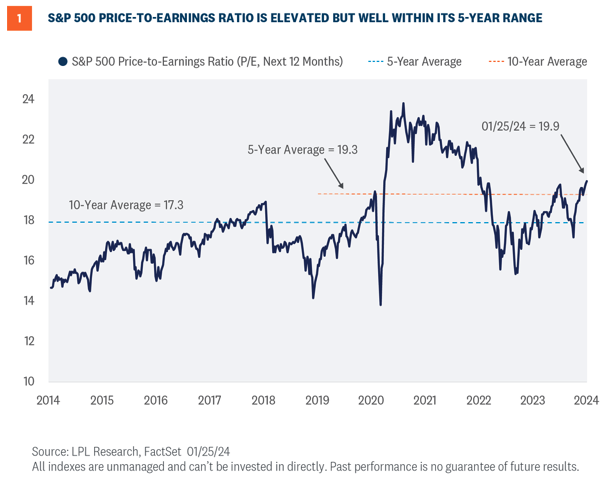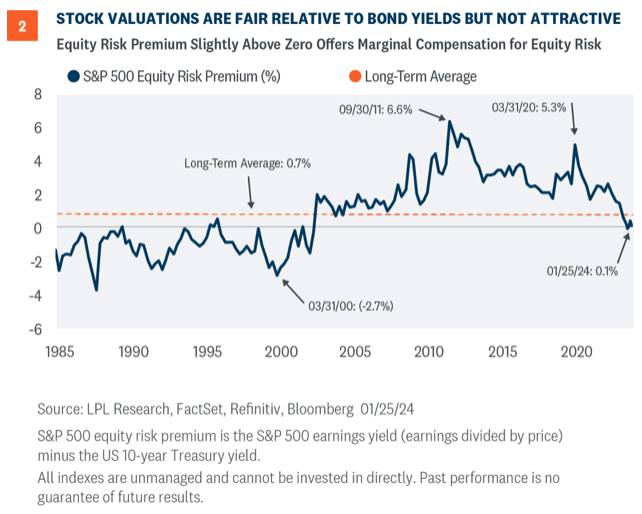With the S&P 500 having recently ascended to a fresh record high after such a strong 2023, it’s natural for investors to worry that valuations have become over-extended. On traditional valuation measures, valuations do appear high, and it does seem reasonable to expect more moderate stock market returns going forward. Here we walk through several different stock valuation approaches to get a more complete picture and even make the case that they aren’t as pricey as they look.
Stocks Are Expensive By Traditional Valuation Measures
Based on the most common valuation metrics, such as the price-to-earnings ratio (P/E), stock market valuations are elevated. The S&P 500 Index is trading at a P/E near 20 times the consensus earnings estimate for the next 12 months (source: FactSet), compared to the long-term average of roughly 17 (Figure 1).

While we acknowledge this P/E is on the high side, if there was a time to pay up for earnings it should be when growth is reaccelerating after a downturn. Recall S&P 500 earnings were in recession last year, with year-over-year earnings growth resuming in the third quarter after three straight quarters of earnings declines. While LPL Research expects 7–8% growth in S&P 500 earnings per share this year, a soft-landing scenario could lift earnings beyond that forecast, making stocks look a bit cheaper.
Those soft-landing prospects are brighter given it’s an election year, which could bring additional stimulus from the Biden Administration, with or without congressional approval (regulatory actions, or inactions, can also provide an economic lift). The White House is well aware that no U.S. president in modern history has been re-elected when a recession occurs during an election year.
Equity Risk Premium Offers More Complete, Slightly Better, Picture
To get a more complete picture of valuations, we factor in interest rates. History shows higher interest rates have translated into lower stock valuations and vice versa. Consider the fundamental value of a stock is the present value of the company’s future cash flows. That means when we discount future earnings, or cash flows, which is a purer measure of a company’s fundamental value—interest rates come into play. Interest rates also matter to stock valuations because bonds compete with stocks for investors’ investment dollars.
So, to incorporate interest rate levels into our evaluation of P/E ratios and get this fuller picture, we calculate an equity risk premium, or ERP. This statistic compares the earnings yield on the S&P 500 (the inverse of the P/E) to the 10-year U.S. Treasury yield. Essentially, an ERP compares the earnings generated by stocks to the income generated by bonds (in this case, the yield on the 10-year Treasury). By putting stocks and bonds in the same terms, they can be compared on an apples-to-apples basis to see if investors are getting enough earnings “compensation” for the additional risk they are taking by owning equities relative to lower-risk Treasury bonds.
As of January 25, 2024, the ERP for the S&P 500 Index was 0.1%, which is below the long-term average of 0.7% (Figure 2). (Higher values mean stocks are less expensive relative to bonds, and vice versa.) Using the consensus earnings estimate for the next 12 months rather than the last 12 months pushes the ERP up to a more attractive level near 1%, but even at that number, the case for stocks over bonds on valuations is difficult to make. In other words, even factoring in relatively low interest rates by historical standards, with the 10-year yield near 4%, at best we can argue stock valuations are fair. Strong momentum and corporate fundamentals leave us comfortable with our neutral tactical stance on equities, but there is not much room for error. And we should watch the risks closely, particularly geopolitics.

Cash Flow Valuations Tell A Similar Story
Earnings are an accounting measure that can be distorted and shifted around, even while following generally accepted accounting practices (GAAP). For that reason, we view cash flows as potentially more important than earnings and a purer measure of the profits a business generates over time.








